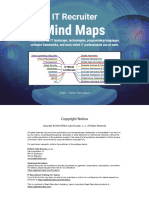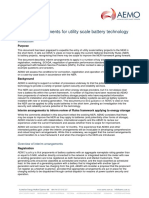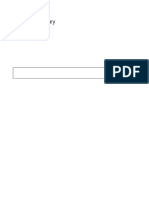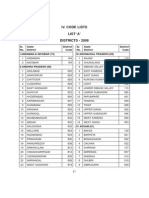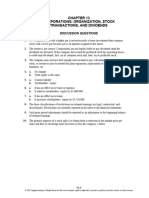Grid Forming BESS Connection Fact Sheet
Grid Forming BESS Connection Fact Sheet
Uploaded by
Alan ZorkotCopyright:
Available Formats
Grid Forming BESS Connection Fact Sheet
Grid Forming BESS Connection Fact Sheet
Uploaded by
Alan ZorkotCopyright
Available Formats
Share this document
Did you find this document useful?
Is this content inappropriate?
Copyright:
Available Formats
Grid Forming BESS Connection Fact Sheet
Grid Forming BESS Connection Fact Sheet
Uploaded by
Alan ZorkotCopyright:
Available Formats
Grid-forming BESS
Connections
This fact sheet contains information the NEM should always seek expert technical and
regulatory advice specific to their circumstances.
relevant to parties seeking to connect
battery energy storage systems Context
(BESS) with grid-forming inverter Grid-forming inverters set their own internal voltage
capabilities within the National waveform reference and can synchronise with the grid
or operate independently of other generation5. Grid-
Electricity Market (NEM), as of forming inverters with a firm energy source behind
December 2022. For additional them may be able to replace many of the capabilities
historically provided by synchronous generators as the
context, readers are recommended to
power system moves toward operation with high
also review the white paper on the penetrations of inverter-based resources (IBR). With
Application of Advanced Grid-scale focused engineering development, grid-forming BESS
may be able to deliver capabilities such as inertia and
Inverters in the NEM which is available system strength support to the future power system.
on the Australian Energy Market AEMO has prepared this document to provide
Operator (AEMO) website1. guidance to grid-forming BESS connection applicants
by summarising the approach to connecting these
This document relates to the connection of standalone projects under current technical and regulatory
BESS2 under rule 5.3 of the National Electricity Rules frameworks, and to highlight NER clauses that require
(NER)3, which require the negotiation of access particular attention and early discussion with the
standards under NER 5.3.4A and schedule 5.2. Hybrid relevant Network Service Provider (NSP).
connections and/or embedded connections under
NER 5.3A may require separate consideration by Connection and registration
connection applicants. This document does not
account for amendments the ‘Integrating energy process
storage systems into the NEM’ rule change will
introduce into the NER.4 The processes for connecting and registering a grid-
forming BESS in the NEM remain the same as for a
While AEMO has taken reasonable care in preparing grid-following BESS. However, grid-forming BESS are
this document, the information is necessarily general a comparatively new technology in the NEM, and
and is not to be construed as advice. Any investor in
3
1
https://aemo.com.au/-/media/files/initiatives/engineering- Version 189 at time of publication
4
framework/2021/application-of-advanced-grid-scale-inverters-in-the-nem.pdf https://www.aemc.gov.au/rule-changes/integrating-energy-storage-systems-
nem
5
2
This does not preclude other types of applications or connection A more detailed definition of grid-forming can be found in AEMO’s
arrangements for the use of grid-forming inverter technology. “Application of Advanced Grid-scale Inverters in the NEM” white paper.
© AEMO 2022 | Grid-forming BESS Connections 1
Grid-forming BESS Connections
implementations by original equipment manufacturers
(OEM) differ in their approach, available operating
Assessment and access
modes, and level of configurability. Close engagement standards
with the relevant NSP and AEMO is necessary to
facilitate new grid-forming connections. Subject to a number of conditions, BESS connection
applicants can negotiate with an NSP (who is advised
It is critical to contact the relevant NSP early in the
on some matters by AEMO) on the access standards
pre-feasibility phase to discuss your proposal
for their proposed connection to the power system
prior to consideration of plant and model tuning.
under NER schedule 5.2. For each technical
Further information on NEM connection and requirement in schedule 5.2, negotiation can occur
registration processes is available on AEMO’s within a range between an automatic access standard
website6. (where a connection cannot be denied access on the
basis of that technical requirement) and a minimum
Performance tuning access standard (below which a connection must be
denied access).
Well-tuned grid forming inverters have the potential to
support the operation of grid-following inverters in their The current technical requirements were not
vicinity and contribute positively to the stability of the developed with specific consideration of grid-forming
power system. A grid-forming BESS design that seeks inverters. Applicants will need to work closely with the
to maximise delivery of power system capabilities such relevant NSP and AEMO to identify ways to optimise
as inertia and system strength must also consider how the ability of this technology to support the power
these capabilities might positively or negatively impact system within the context of the access standards.
its ability to meet the applicable access standards. This may mean, particularly for NER clauses S5.2.5.5
and S5.2.5.13, that a performance standard other than
Any grid-forming design should also consider whether
the automatic access standard could be preferred.
the performance tuning of the plant might influence its
ability to deliver services to the power system, either Synchronous vs. asynchronous
under current or future NEM mechanisms. Service Several of the access standards defined in NER
delivery is not within the scope of this document7. Schedule 5.2 differ depending on whether the
generating unit is synchronous or asynchronous8.
Inertia and system strength are valuable Grid-forming BESS are asynchronous generating
capabilities that can support power system units, by definition, for the purposes of connection
stability, but maximising their provision may not applications.
be appropriate or viable at all network locations. The assessment process for a grid-forming BESS is
therefore the same as for any other asynchronous
generator. However, the performance of this
6 8
https://aemo.com.au/energy-systems/electricity/national-electricity-market- Asynchronous generators are often referred to as inverter-based resources
nem/participate-in-the-market/network-connections and or non-synchronous generators. The terms synchronous and asynchronous
https://aemo.com.au/energy-systems/electricity/national-electricity-market- are used here in line with their definitions in NER chapter 10.
nem/participate-in-the-market/registration
7
For further information on system security framework developments under
the NEM2025 program, see: https://aemo.com.au/initiatives/major-
programs/nem-reform-implementation-roadmap
© AEMO 2022 | Grid-forming BESS Connections 2
Grid-forming BESS Connections
technology differs from other asynchronous generators capability with sufficient time duration to coordinate
(such as grid-following inverters) and can in some with transformer tap operation may be used to
instances be designed to mimic the behaviour of a manage temporary current increases in this voltage
synchronous machine. This can have implications for range, beyond steady-state values, and to maintain
their ability to comply with some NER schedule 5.2 continuous uninterrupted operation.
requirements.
S5.2.5.5 Generating system response to
Application of NER schedule 5.2 to grid- disturbances following contingency events
forming BESS
The assessment of this clause seeks to verify plant is
Applicants seeking to connect a grid-forming BESS able to remain in continuous uninterrupted operation
must comply with all relevant access standards. Within for a range of contingency events and ensure that the
these standards, close attention should be paid to plant does not have a negative impact on the system it
specific clauses where the control methodologies and is connecting to. A grid-forming inverter opposes the
behaviour of this technology could lead to a grid- voltage change caused by a fault and opposes a
forming inverter performing differently from grid- frequency rate of change caused by a supply-demand
following inverters that applicants may be more imbalance. It will also change active power in
familiar with. response to a voltage angle change, which can assist
Specifically, AEMO recommends that applicants in limiting vector shift and improve stability. Because of
carefully assess that their proposal meets the these characteristics the grid-forming inverter has the
requirements of the following clauses: potential to contribute positively to the power system
by reducing the impact of contingency events, but
S5.2.5.4 Generating System Response to Voltage inappropriate tuning can also have adverse impacts on
Disturbances the power system. There are often trade-offs between
Grid-forming inverters may respond almost tuning for various characteristics. The performance
instantaneously to voltage disturbances. Near characteristics of grid-forming inverters will need to be
instantaneous response to counteract voltage tuned to ensure negative impacts to the system are
disturbance is a beneficial characteristic that helps to limited, while maximising the aspects of this
stabilise the network voltage. technology that are beneficial to the power system.
A grid-forming inverter will begin increasing its Tuning for optimal power system performance might
injection of reactive current at voltages above 90% of require the grid forming inverter to be modelled by the
connection point normal voltage, and some NSP-appropriate wide area model and might be an
implementations might exceed the steady-state iterative process.
reactive current values that are consistent with There are some aspects of the current NER clause
reactive power requirements of NER clause S5.2.5.1. S5.2.5.5 wording that are not well targeted to the
Applicants should ensure that for operation in the performance characteristics of grid-forming inverters,
range 90% to 110% of connection point voltage the including paragraph (g) of the automatic access
generating system is able to maintain continuous standard and paragraph (o) in the corresponding
uninterrupted operation9 for its active power. Overload minimum access standard which consider reactive
current commencement, rise time and settling time.
9
Within the meaning of the NER.
© AEMO 2022 | Grid-forming BESS Connections 3
Grid-forming BESS Connections
These provisions are challenging because the reactive In some locations, such as in radial areas of the
current response of grid-forming inverters may not distribution network, specific disconnection
settle to a steady value over the duration of the fault. functionality or trip schemes may still be required to
This may affect rise time as well as settling time. In ensure the BESS is disconnected where islanding is
addition, the rapid reactive current response may unwanted or inappropriate.
change the voltage profile of the fault, affecting the
S5.2.5.13 Voltage and reactive power control
calculated rise time.
The objective in tuning the voltage and reactive
Noting that a connection applicant must demonstrate
controls should be to optimise the performance of the
performance that is ‘no less onerous’ than the
power system, within the range of access standard
minimum access standard, AEMO supports a flexible
requirements. The proponent should discuss site-
approach to drafting of generator performance
specific connection point conditions and tuning
standards for grid-forming BESS in these instances,
objectives and trade-offs with the NSP.
for these subclauses. For example, AEMO and the
NSP could decide not to specify requirements for Tuning of generating systems for this clause should
response durations, on the basis that the system is consider optimising the performance across the full
instead required to commence its response range of short-circuit levels anticipated for the
immediately following a change in voltage at the connection point. For the high end of the range the
inverter terminals. response to a step change in voltage will be slower but
more stable. At the lower end the performance will be
To address these issues in the medium term, AEMO
faster but less stable. The power system will generally
has proposed amendments to NER S5.2.5.5 and
tolerate slower response at high fault levels, but
suggests that applicants review its submission to the
stability could be reduced further for non-credible
‘Efficient reactive current access standards for
contingency events, particularly when fault level prior
inverter-based resources’ Rule change10.
to the contingency event is low. The tuning should
S5.2.5.8 Protection of Generating Systems from therefore prioritise stability of response at low fault
Power System Disturbances levels over speed of response at high fault levels,
where there is a trade-off between them.
Grid-forming inverters often have the capability to
survive the formation of an electrical island, and Tuning should be focussed on the quality of response
potentially sustain the operation of that island in for power system disturbances. Although in normal
conjunction with other generators and network assets. power system operating conditions setpoint steps are
This capability will be valuable during islanding and not important, response to power system disturbances
system split events involving few or no synchronous is of critical importance for maintaining power system
machines. It is recommended that, when agreed upon security.
by AEMO and the NSP, grid-forming BESS remain
online during these events wherever stable operation
for both voltage and frequency can be maintained.
10
Available from the Australian Energy Market Commission (AEMC) website:
https://www.aemc.gov.au/rule-changes/efficient-reactive-current-access-
standards-inverter-based-resources
© AEMO 2022 | Grid-forming BESS Connections 4
Grid-forming BESS Connections
Related work System security rule changes being progressed by
the AEMC, with implementation as part of the
The regulatory landscape around grid-forming BESS is NEM2025 program to be led by AEMO and
rapidly evolving. AEMO strongly recommends that coordinated through the Reform Delivery
developers and potential applicants maintain Committee (encompassing, in particular, the
awareness and involvement in reform activities AEMC’s rule change process on an Operational
relevant to their projects. For example, as of security mechanism15).
November 2022 significant reform initiatives include: AEMC rule change process on integrating energy
AEMC rule change process on Efficient reactive storage systems into the NEM16, and subsequent
current access standards for inverter-based implementation activities by AEMO17.
resources11 (as referenced above) Jurisdictional frameworks relating to Renewable
Implementation of efficient management of Energy Zones (REZs)
system strength on the power system rule12, by AEMO’s Engineering Framework18, which
AEMO13 and NSPs. identifies several priority actions relating to grid-
AEMO’s review of NER Schedules 5.2, 5.3 and forming BESS.
5.3 mandated under NER clause 5.2.6A
Australian Renewable Energy Agency (ARENA)’s
large scale battery storage funding round14
11 15
https://www.aemc.gov.au/rule-changes/efficient-reactive-current-access- https://www.aemc.gov.au/rule-changes/operational-security-mechanism
standards-inverter-based-resources 16
https://www.aemc.gov.au/rule-changes/integrating-energy-storage-systems-
12
https://www.aemc.gov.au/rule-changes/efficient-management-system- nem
strength-power-system 17
https://aemo.com.au/initiatives/major-programs/integrating-energy-storage-
13
https://aemo.com.au/consultations/current-and-closed- systems-project
consultations/ssrmiag 18
https://aemo.com.au/en/initiatives/major-programs/engineering-framework
14
That will provide up to $100 million to accelerate demonstration of
advanced inverter capabilities: https://arena.gov.au/funding/large-scale-
battery-storage-funding-round
© AEMO 2022 | Grid-forming BESS Connections 5
You might also like
- HYPERION Installation Manual Double GlassDocument15 pagesHYPERION Installation Manual Double GlassAlan ZorkotNo ratings yet
- IT Recruiter Mind-Maps - BookletDocument26 pagesIT Recruiter Mind-Maps - BookletMiran Kostic100% (2)
- Jhon Furio Classpoint Act.Document2 pagesJhon Furio Classpoint Act.Jhon FurioNo ratings yet
- Epstein and O'Halloran - 1999 - Delegating Powers A Transaction Cost Politics AppDocument423 pagesEpstein and O'Halloran - 1999 - Delegating Powers A Transaction Cost Politics AppJosé Manuel MejíaNo ratings yet
- Automated Broad and Narrow Band Impedance Matching for RF and Microwave CircuitsFrom EverandAutomated Broad and Narrow Band Impedance Matching for RF and Microwave CircuitsNo ratings yet
- 1kw Sine Wave Inverter Circuit Diagram PDFDocument10 pages1kw Sine Wave Inverter Circuit Diagram PDFAndone Anutu100% (1)
- Grid CodeDocument15 pagesGrid CodeNedim HadžiaganovićNo ratings yet
- GFM BESS Requirements - Fingrid - V1 - 20230621Document12 pagesGFM BESS Requirements - Fingrid - V1 - 20230621luliang.phdNo ratings yet
- Connection Application ChecklistDocument13 pagesConnection Application ChecklistSyedUsmaanNo ratings yet
- Source Independent Zone-1 (Accepted) PDFDocument11 pagesSource Independent Zone-1 (Accepted) PDFSubhadeep PaladhiNo ratings yet
- ESIG-GFM-deployment-1-pager-2022Document1 pageESIG-GFM-deployment-1-pager-2022nlc149566No ratings yet
- NDP GlossaryDocument10 pagesNDP GlossaryimuonechanceNo ratings yet
- 29 BessDocument6 pages29 BessluthfiNo ratings yet
- 20240312 IPWG Item 04a GFM Need Drivers Technology Landscape (PAC-2024-2)_ESIG632108Document19 pages20240312 IPWG Item 04a GFM Need Drivers Technology Landscape (PAC-2024-2)_ESIG632108nlc149566No ratings yet
- 2005 HiermannDocument7 pages2005 Hiermannsamsularief03No ratings yet
- G99 Main Chapters v5 01082017Document116 pagesG99 Main Chapters v5 01082017Bruce CoxNo ratings yet
- مقاله مونتاژDocument16 pagesمقاله مونتاژAkbar zamani alishahNo ratings yet
- 2024 Promises and Challenges of Grid Forming Transmission System Operator Manufacture and Academic View PointsDocument35 pages2024 Promises and Challenges of Grid Forming Transmission System Operator Manufacture and Academic View PointsJorge Luis Vega HerreraNo ratings yet
- Ensuring Grid Code Harmonic Compliance of Wind Farms: D.M. Joseph, P. Haigh and J. MccullaghDocument6 pagesEnsuring Grid Code Harmonic Compliance of Wind Farms: D.M. Joseph, P. Haigh and J. MccullaghÖnder PolatNo ratings yet
- CSE20240203_Part18Document1 pageCSE20240203_Part18AbcoNo ratings yet
- DIgSILENT Pacific Submission To Power and Water Corporation Consultation On System Strength and Model GuidelinesDocument12 pagesDIgSILENT Pacific Submission To Power and Water Corporation Consultation On System Strength and Model GuidelineskevinkiangebeiNo ratings yet
- License Siemens Ltd./SA-32377 Not For Resale, 1/17/2022 5:30:33 PM Saudi TimeDocument6 pagesLicense Siemens Ltd./SA-32377 Not For Resale, 1/17/2022 5:30:33 PM Saudi TimeMobashirNo ratings yet
- Siemens SW Improving The Reliability and Performance of RF ICS WP 83544 C2Document9 pagesSiemens SW Improving The Reliability and Performance of RF ICS WP 83544 C2J HARSHA YADAVNo ratings yet
- Grid Forming Battery StorageDocument18 pagesGrid Forming Battery Storageniniwu713No ratings yet
- Huiguangliang 2011Document6 pagesHuiguangliang 2011Jam 234No ratings yet
- Power Quality Analysis in ElectricaDocument8 pagesPower Quality Analysis in ElectricaBhargavi KmNo ratings yet
- Interim Arrangements For Utility Scale Battery TechnologyDocument7 pagesInterim Arrangements For Utility Scale Battery TechnologyJonathan SmithNo ratings yet
- Development of Combined Control System To Improve Grid FaultsDocument8 pagesDevelopment of Combined Control System To Improve Grid FaultsKhaja SameeduddinNo ratings yet
- Yang 2012Document8 pagesYang 2012amina bu bakerNo ratings yet
- CIRED2017 - 0057 - Final RULES DRIVEN PROJECT SPECIFICATION IN THE CONTEXT OF IEC 61850 BASIC APPLICATION PROFILESDocument5 pagesCIRED2017 - 0057 - Final RULES DRIVEN PROJECT SPECIFICATION IN THE CONTEXT OF IEC 61850 BASIC APPLICATION PROFILESChris ParkinsonNo ratings yet
- Grid-Forming Vs Grid-FollowingDocument11 pagesGrid-Forming Vs Grid-Followingtru.playaNo ratings yet
- Importance and Conduct of Grid Impact StudyDocument24 pagesImportance and Conduct of Grid Impact StudyJCuchapinNo ratings yet
- A Novel Resilient Control of Grid-Integrated Solar PV-Hybrid Energy Storage Microgrid For Power Smoothing and Pulse Power Load AccommodationDocument16 pagesA Novel Resilient Control of Grid-Integrated Solar PV-Hybrid Energy Storage Microgrid For Power Smoothing and Pulse Power Load AccommodationARUNIMA SNo ratings yet
- License Siemens Ltd./SA-32377 Not For Resale, 1/17/2022 5:31:45 PM Saudi TimeDocument6 pagesLicense Siemens Ltd./SA-32377 Not For Resale, 1/17/2022 5:31:45 PM Saudi TimeMobashirNo ratings yet
- TES-P-103.01 (Rev 01)Document6 pagesTES-P-103.01 (Rev 01)Ezz El Dinn SabriNo ratings yet
- Dfigxxx ImportantDocument11 pagesDfigxxx ImportantAhmed WestministerNo ratings yet
- Load Frequency Control in Microgrids Based On A Stochastic Non-Integer ControllerDocument9 pagesLoad Frequency Control in Microgrids Based On A Stochastic Non-Integer ControllerPraful YadavNo ratings yet
- A Control-Based Solution For Distance Protection of Lines Connected To Converter-Interfaced Sources During Asymmetrical FaultsDocument11 pagesA Control-Based Solution For Distance Protection of Lines Connected To Converter-Interfaced Sources During Asymmetrical FaultsVinod VijayachandranNo ratings yet
- 9th-Distribution Substation AutomationDocument4 pages9th-Distribution Substation AutomationNguyễn Tiến PhướcNo ratings yet
- SSDG Grid Code - Rev Sept 2019Document33 pagesSSDG Grid Code - Rev Sept 2019Ashfaaq OchatoyaNo ratings yet
- energies-16-02502-v2Document36 pagesenergies-16-02502-v2zabidintechNo ratings yet
- Inverters Model ForshortcctDocument12 pagesInverters Model ForshortcctAbdul Basit TajNo ratings yet
- PSS Scopes For LSSDocument14 pagesPSS Scopes For LSSsyafiqishamuddinNo ratings yet
- A Reliable Accelerated Protection Scheme For Converter-Dominated Power NetworksDocument10 pagesA Reliable Accelerated Protection Scheme For Converter-Dominated Power NetworksTevin James yigaNo ratings yet
- Tax Comparison of Fixed and Mobile Cost StructuresDocument16 pagesTax Comparison of Fixed and Mobile Cost Structuresdhruv jainNo ratings yet
- Using AC Optimal Power Flow For DG Planning and OptimisationDocument7 pagesUsing AC Optimal Power Flow For DG Planning and OptimisationAhmed WestministerNo ratings yet
- Connection of Embedded Generating Plant Up To 5MW: Engineering Recommendation No.3 of The Electricity Distribution CodeDocument12 pagesConnection of Embedded Generating Plant Up To 5MW: Engineering Recommendation No.3 of The Electricity Distribution CodeWael AlmassriNo ratings yet
- Integrated V2G G2V and Renewable Energy PDFDocument10 pagesIntegrated V2G G2V and Renewable Energy PDFpratap68No ratings yet
- Adaptive Control Strategies and Communications For Utility Integration of Photovoltaic Solar SitesDocument9 pagesAdaptive Control Strategies and Communications For Utility Integration of Photovoltaic Solar SitesYahya ZabenNo ratings yet
- 2024 Performance - Specifications - For - Grid-Forming - TechnologiesDocument5 pages2024 Performance - Specifications - For - Grid-Forming - TechnologiesJorge Luis Vega HerreraNo ratings yet
- Multi-Objective Framework For Optimal Scheduling of Electric VehiclesDocument6 pagesMulti-Objective Framework For Optimal Scheduling of Electric VehiclesHabib KraiemNo ratings yet
- CSE20240203_Part12Document1 pageCSE20240203_Part12AbcoNo ratings yet
- Grid Forming CapabilitiesDocument10 pagesGrid Forming CapabilitiesGabriel VilknNo ratings yet
- Gentestingbnetechnov 12Document54 pagesGentestingbnetechnov 12DdwsdgcfNo ratings yet
- A Two-Stage Scheduler of Distributed Energy ResourcesDocument6 pagesA Two-Stage Scheduler of Distributed Energy ResourcesVemalaiah KasiNo ratings yet
- A Generic Primary-Control Model For Grid-Forming InvertersDocument10 pagesA Generic Primary-Control Model For Grid-Forming InvertersXuheng LinNo ratings yet
- (2017) - Shafiullah - A Review On Distribution Grid Fault Location TechniquesDocument19 pages(2017) - Shafiullah - A Review On Distribution Grid Fault Location TechniquesJamile_P_NNo ratings yet
- PriorArt 19Document10 pagesPriorArt 19karimarabiNo ratings yet
- 3.VPP Presentation of Task 2 Part23 en FinalDocument24 pages3.VPP Presentation of Task 2 Part23 en FinalTrần Quang MinhNo ratings yet
- Synchronization Solutions in 5g Transport NetworkDocument16 pagesSynchronization Solutions in 5g Transport NetworkSmahjoobNo ratings yet
- Power Network Telecommunication: Siemens Power Engineering Guide Transmission and Distribution 4th EditionDocument14 pagesPower Network Telecommunication: Siemens Power Engineering Guide Transmission and Distribution 4th EditionGabriel ApavaloaieiNo ratings yet
- Modern Trends in Power System Protection For Distribution Grid With High DER PenetrationDocument22 pagesModern Trends in Power System Protection For Distribution Grid With High DER Penetrationaurysllan - UFPI100% (1)
- CRA-Whitepaper-BESS_October_2023Document22 pagesCRA-Whitepaper-BESS_October_2023matevzNo ratings yet
- Adobe Scan 07 Jan 2025 (1)Document3 pagesAdobe Scan 07 Jan 2025 (1)lakshaysarsNo ratings yet
- WEM Reform Market Design SummaryDocument134 pagesWEM Reform Market Design SummaryAlan ZorkotNo ratings yet
- Registration and Participation Framework in The Wholesale Electricity MarketDocument31 pagesRegistration and Participation Framework in The Wholesale Electricity MarketAlan ZorkotNo ratings yet
- EG4® 18kPV Version 1 External RSD Initiator Install InstructionsDocument9 pagesEG4® 18kPV Version 1 External RSD Initiator Install InstructionsAlan ZorkotNo ratings yet
- Communication Systems: On Board Indian Naval ShipDocument32 pagesCommunication Systems: On Board Indian Naval Shipkoustav0212100% (2)
- Network SecurityDocument13 pagesNetwork SecurityNitish GuptaNo ratings yet
- Effects of The Contract When The Thing Sold Has Been Lost 1. Loss (1493-1494)Document3 pagesEffects of The Contract When The Thing Sold Has Been Lost 1. Loss (1493-1494)ChaNo ratings yet
- Corporation Law Cases 1 15Document128 pagesCorporation Law Cases 1 15Ten LaplanaNo ratings yet
- Submitted To: Sir Jawad Abdul Ghaffar Submitted By: Muhammad ZaheerDocument36 pagesSubmitted To: Sir Jawad Abdul Ghaffar Submitted By: Muhammad ZaheerAli Abbas HadiNo ratings yet
- ECOM058 Principles of AccountingDocument4 pagesECOM058 Principles of AccountingNguyễn Thị Thùy TrangNo ratings yet
- VV IMP File of Codes by RBI - Sectrol & Region WiseDocument60 pagesVV IMP File of Codes by RBI - Sectrol & Region WiseVishal JainNo ratings yet
- Control Systems ApplicationDocument6 pagesControl Systems ApplicationRitesh SinghNo ratings yet
- Group4 Section1 Tyco InternationalDocument8 pagesGroup4 Section1 Tyco InternationalRamyaa Ramesh100% (1)
- Torrefaction of Wood - Par 2 PDFDocument6 pagesTorrefaction of Wood - Par 2 PDFVictor Fassina BroccoNo ratings yet
- Assignment SampDocument13 pagesAssignment Sampanuja pandeyNo ratings yet
- Generator ProtectionDocument24 pagesGenerator ProtectionSantoshkumar Gupta100% (2)
- MESC Description PI04Document4 pagesMESC Description PI04Reastu SaputraNo ratings yet
- FR 4Document3 pagesFR 4Amit YadavNo ratings yet
- Ipsos 2022 FIFA World Cup Global Advisor Survey Report - Public VersionDocument23 pagesIpsos 2022 FIFA World Cup Global Advisor Survey Report - Public VersionAris DarussalamNo ratings yet
- Series: Model NumberDocument2 pagesSeries: Model Numberrobbi kurniawanNo ratings yet
- Catalog Supplement: New ProductsDocument4 pagesCatalog Supplement: New ProductsFaizal JamalNo ratings yet
- Module 5Document118 pagesModule 5Naresh Batra AssociatesNo ratings yet
- Chapter 13Document42 pagesChapter 13Peo PaoNo ratings yet
- Es324 - 132kv To Lower Voltage Transformers and Earthing or Auxiliary TransformersDocument129 pagesEs324 - 132kv To Lower Voltage Transformers and Earthing or Auxiliary Transformersiman tabataba'iNo ratings yet
- UMTS TutorialDocument84 pagesUMTS Tutorialnale_2100% (1)
- Association of Mutual Funds in India: Registration Form For CorporateDocument5 pagesAssociation of Mutual Funds in India: Registration Form For CorporateManish SumanNo ratings yet
- Liebert DSE Packaged: Job Name Model DP060DP Quantity Date Invoice # Purchaser P.O. # Tag # Submitted byDocument18 pagesLiebert DSE Packaged: Job Name Model DP060DP Quantity Date Invoice # Purchaser P.O. # Tag # Submitted byDominik ŠvigirNo ratings yet
- 2011 California Rules of Court Summery JudgmentDocument6 pages2011 California Rules of Court Summery JudgmentdsnetworkNo ratings yet
- Dear Students and Parents: St. Xavier'S Collegiate School, KolkataDocument4 pagesDear Students and Parents: St. Xavier'S Collegiate School, KolkataXXXNo ratings yet
- 2022 Summer OrganizedDocument31 pages2022 Summer Organizedsayedshaad02No ratings yet

